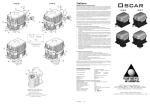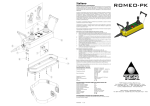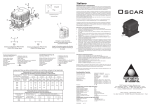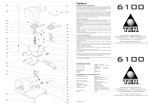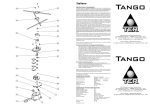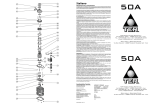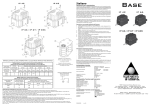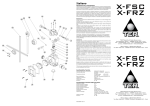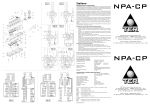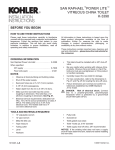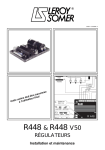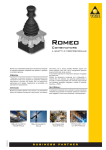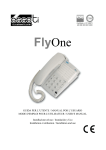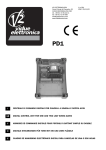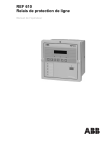Download Italiano
Transcript
Schema Cablaggio A Wiring Layout A Schema Cablaggio B Schema Cablaggio B Wiring Layout B Wiring Layout B Italiano Istruzioni d’uso e manutenzione Il combinatore Romeo è un dispositivo elettromeccanico per circuiti di comando/controllo e manovra a bassa tensione (EN 60947-1, EN 60947-5-1) da utilizzarsi come equipaggiamento elettrico di macchine (EN 60204-1) in conformità a quanto previsto dai requisiti essenziali della Direttiva Bassa tensione 2006/95/CE e della Direttiva Macchine 2006/42/CE. P2 P3 P4 Il combinatore Romeo è previsto per impiego in ambiente industriale con condizioni climatiche anche particolarmente gravose (temperature di impiego da –25°C a +70°C ed idoneità per utilizzo in ambienti tropicali). L’apparecchio non è idoneo per impiego in ambienti con atmosfere potenzialmente esplosive, in presenza di agenti corrosivi od elevata percentuale di cloruro di sodio (nebbia salina). Il contatto con oli, acidi e solventi può danneggiare l’apparecchio; evitare di usarli per operazioni di pulizia. Non è consentito collegare più di una fase per ogni interruttore. Non oliare od ingrassare gli interruttori e i relativi attuatori. P5 P2 P1 1 Se i combinatori sono provvisti di blocco meccanico, non manovrare la leva di comando prima di aver disinserito l’apposito blocco sollevando la parte inferiore del pomolo (01) questa manovra attiva anche l’interruttore centrale dedicato. Se i combinatori sono provvisti di pulsante “Uomo Morto” l’abilitazione alle manovre si ottiene premendo il pulsante (P1), inoltre azionando gli eventuali pulsanti / selettori (P2, P3, P4, P5) si attivano le funzioni previste. P1 3 4 5 3 3 4 4 In relazione alle condizioni di installazione, di impiego e alla valutazione dei requisiti essenziali ai fini della sicurezza e della tutela della salute il combinatore deve essere installato in modo da garantire adeguata protezione dell’equipaggiamento in generale e delle parti attive in particolare (protezione contro la scossa elettrica e protezione contro l’ingresso di corpi solidi e liquidi). 5 5 Romeo L’installazione del combinatore Romeo deve essere effettuata da personale competente ed addestrato. I cablaggi elettrici devono essere effettuati a regola d’arte secondo le disposizioni vigenti. Prima di eseguire l’installazione e la manutenzione del combinatore Romeo è necessario togliere l’alimentazione principale della macchina. Il combinatore è completo di sacchetto accessori che contiene: n°4 viti metriche (04). Dispositivo 1 Dispositivo 2 Device 1 Dispositivo 3 Device 2 Device 3 Green 1 2 3 Dispositivo Device Posizione Blue White 50% Numero Pin Funzione Position Pin number Function 23 27 26 25 24 22 Red Disponibile per tutti i modelli Avaiable for all models Schema di cablaggio A 17 C 1V NC 17 C 2V NC 7 8 NC 1V C 9 NC 3V C 17 17 9 16 C C A 1V 3V NC NC 1 8 16 5 B 3 1V 2V C C 16 17 16 3 21 1 NC 18 4 2 2 19 6 4 NC 20 7 NC 20 NO C 15 13 16 C C 4V 6V A 1V 3V NC NC NC NC 10 12 1 16 C C C 1V NC 17 C 2V NC 11 5V NC 14 8 6 NC 1V C 9 NC 3V C Conformità alle Direttive Comunitarie Conformità alle Norme Temperatura ambiente 17 17 16 7 6 18 5 17 4 16 3 2 11 3 16 C C 4V 6V NC NC 10 12 NC NC NC B 16 1V 11 22 2V C C 16 16 13 NC 4V C 17 15 NC 6V C 17 23 15 25 13 27 11 17 C C 26 12 5V NC 14 NC 5V 24 14 10 C 7 8 16 4 2 C 12 17 17 9 21 16 5V 14 10 Caratteristiche Tecniche 1 19 16 TER declina ogni responsabilità da danni derivanti dall’uso improprio dell’apparecchio o da una sua installazione non corretta. C D 6 Qualsiasi modifica ai componenti del combinatore annulla la validità dei dati di targa ed identificazione dell’apparecchio e fa decadere i termini di garanzia. In caso di sostituzione di un qualsiasi componente utilizzare esclusivamente ricambi originali. Wiring Layout B C D Operazioni di manutenzione periodica - verificare il corretto serraggio delle viti (04) di fissaggio del combinatore sul supporto - verificare il corretto funzionamento del blocco meccanico (01) se presente - verificare il corretto funzionamento meccanico del pulsante “Uomo Morto”(P1) se presente - verificare il corretto funzionamento meccanico dei pulsanti / selettori (P2, P3, P4, P5) se presenti - verificare le condizioni dei cablaggi (in particolare nella zona dei morsetti) - verificare le condizioni del soffietto (03) del combinatore Schema di cablaggio B Wiring Layout A Operazioni per una corretta installazione del combinatore 1- effettuare la foratura Ø 60 sul supporto prescelto (supporto con spessore di 4 mm) (per una corretta foratura, utilizzare l’apposita maschera fornita su richiesta) 2- inserire il combinatore nel foro del supporto (comprimere leggermente il soffietto del combinatore (03) per un corretto inserimento dell’apparecchio) 3- posizionare la targhetta (05) provvista di guarnizione sul combinatore 4- avvitare le viti (04) facendo corrispondere i fori della targhetta (05) con quelli effettuati sul supporto e con quelli filettati sul combinatore (porre attenzione al corretto posizionamento della guarnizione tra il combinatore ed il supporto) 5- spelare il cavo multipolare per una lunghezza adeguata alle operazioni di connessione elettrica con i morsetti 6- fissare il cavo multipolare in modo da evitare la possibilità di trazione esterna sulle connessioni 7- effettuare le connessioni elettriche con i morsetti rispettando lo schema di cablaggio riportato sul retro delle istruzioni, consigliabile l’impiego di puntali. Grado di protezione Categoria di isolamento Posizioni di funzionamento Capacità di serraggio del morsetto Coppia di serraggio del morsetto 2006/95/CE 2006/42/CE EN 60204-1 EN 60947-1 EN60947-5-1 Immagazzinaggio -40°C/+70°C Funzionamento -25°C/+70°C IP 00 Classe I Tutte le posizioni 0,2 / 2,5 mm2 50 /60 cNm Marcature C Caratteristiche Tecniche degli Interruttori Categoria di impiego Corrente nominale di impiego Tensione nominale di impiego Corrente nominale termica Tensione nominale di isolamento Durata meccanica Connessioni Marcature e omologazioni AC 15 2A 48 V~ 8A 60 V~ 0.5x106 manovre Morsettiera 16 e Caratteristiche Tecniche dei Pulsanti / Selettori 13 NC 4V C 17 15 NC 6V C 17 Corrente e Tensione nominale di impiego Corrente e Tensione nominale di impiego Tensione nominale di isolamento Durata meccanica Connessioni PRIS580100 rev. 02 400mA - 32 Vac Resistivo 100mA - 50Vdc Resistivo 60 V~ 6 0.1x10 manovre Morsettiera TER Tecno Elettrica Ravasi s.r.l. Via Garibaldi 29/31 - 23885 Calco (LC) - Italy Tel. +39 039 9911011 - Fax +39 039 9910445 E-mail: [email protected] - www.terworld.com Sede Legale - Registered Office Via San Vigilio 2 - 23887 Olgiate Molgora (LC) - Italy English Français Español Deutsch Use and Maintenance Instructions Instructions d’Emploi et Entretien Instrucciones de Uso y Manutención Betriebs- und Wartungsanweisung The Romeo joystick is an electromechanical device for low voltage control circuits (EN 60947-1, EN 60947-5-1) to be used as electric equipment on machines (EN 60204-1) in compliance with the essential requisites of the Low Voltage Directive 2006/95/CE and the Machine Directive 2006/42/CE. Le combinateur Romeo est un dispositif électromécanique pour circuits de commande/contrôle et manœuvre à basse tension (EN 60947-1, EN 60947-5-1) à utiliser comme équipement électrique sur des machines (EN 60204-1) conformément aux normes essentielles de la Directive Basse Tension 2006/95/CE et de la Directive Machines 2006/42/CE. The Romeo joystick is designed for use in industrialal environments even under severe climatic conditions (working temperatures from -25°C to +70°C and suitable for use in tropical environments). The equipment is not suitable for use in environments with potentially explosive atmosphere, corrosive agents or a high percentage of sodium chloride (saline fog). Oils, acids or solvents may damage the equipment; avoid using them for cleaning. Do not connect more than one phase to each switch. Do not oil or grease the switches and the control elements. Le combinateur Romeo est destiné à être utilisé en milieu industriel y compris dans des conditions climatiques extrêmes (température d’utilisation entre –25 °C et +70 °C et apte à l’utilisation en milieu tropical). L’appareil n’est pas destiné à être utilisé en milieu potentiellement explosif, en présence d’agents corrosifs ou contenant un pourcentage élevé de chlorure de sodium (brouillard salin). Le contact avec des huiles, des acides ou des solvants risque d’endommager l’appareil; éviter de les utiliser pour le nettoyage. Il est interdit de connecter plus d’une phase pour chaque interrupteur. Ne pas huiler ni graisser les interrupteurs ni leurs actionneurs. El combinador Romeo es un dispositivo electromecánico para circuitos de mando / control y maniobra a baja tensión (EN 60947-1, EN 60947-5-1) para ser utilizado como equipamiento eléctrico de máquinas (EN 60204-1) de conformidad con lo previsto por los requisitos esenciales de la Directiva de Baja Tensión 2006/95/CE y de la Directiva sobre Máquinas 2006/42/CE. Der Verbundantrieb Romeo ist eine elektromechanische Vorrichtung für Steuer-/ Regelkreise und Schaltungen mit Niederspannung (EN 60947-1, EN 60947-5-1). Der Verbundantrieb wird als elektrische Ausrüstung von Maschinen (EN 60204-1) in Konformität mit den wesentlichen Bestimmungen der Spannungsrichtlinie 2006/95/CE und der Maschinenrichtlinie 2006/42/CE verwendet. El combinador Romeo está previsto para el empleo en ambiente industrial, con condiciones climáticas incluso especialmente dificultosas (temperaturas de empleo de –25 °C a +70 °C e idoneidad para su utilización en ambientes tropicales). El aparato no resulta adecuado para su empleo en ambientes con atmósferas potencialmente explosivas, en presencia de agentes corrosivos o elevado porcentaje de cloruro de sodio (niebla salina). El contacto con aceites, ácidos y solventes puede dañar el aparato; evitar su uso para operaciones de limpieza. No está permitido conectar más de una fase por cada interruptor. No aceitar ni engrasar los interruptores ni los relativos actuadores. Der Verbundantrieb Romeo ist für den Einsatz in Industrieumgebungen auch unter besonders schwierigen klimatischen Bedingungen (Einsatztemperatur von -25°C bis +70°C sowie Einsatz in den Tropen) geeignet. Das Gerät ist dagegen nicht für den Einsatz in potentiell explosiver Umgebung, in Anwesenheit von korrodierenden Stoffen oder in Umgebungen mit hohem Gehalt an Salz (Salznebel) geeignet. Der Kontakt mit Öl, Säuren und Lösemitteln kann zu einer Beschädigung des Geräts führen; Vermeiden Sie für die Reinigung. Es ist verboten, mehr als eine Phase pro Schalter anzuschließen. Die Schalter und die entsprechenden Antriebe nicht ölen oder schmieren. Si los combinadores están dotados de bloqueo mecánico, no maniobrar la palanca de mando antes de haber desconectado el bloqueo correspondiente elevando la parte inferior del pomo (01), esta maniobra también activa el interruptor correspondiente central. Si los combinadores están dotados de pulsador “Hombre Muerto”, apretar sobre el pulsador (P1) para permitir las maniobras, operando los eventuales botones / selectores (P2, P3, P4, P5), las funzione previstas son activadas. Wenn Verbundantriebe mit mechanischer Sperre ausgestattet sind, darf der Steuerhebel nicht bewegt werden, bevor die entsprechende Sperre durch Hochziehen des Knaufunterteils (01) entriegelt wurde, Dies Betrieb aktiviert auch den zentralen Schalter. Bei dem Fall sind die Verbundantriebe mit Drucktaste „Betrieber abwesend” ausgerüstet, wird die Betrieb beim Drücken der Taste (P1) ermöglicht, Bei aktivieren der Tasten / Selektoren (P2, P3, P4, P5) werden die vorgesehene Funktionen aktiviert. En relación con las condiciones de instalación, de empleo y en base a la valoración de los requisitos esenciales a fines de la seguridad y la protección de la salud, el combinador debe ser instalado de tal forma que garantice adecuada protección del equipamiento en general y de las partes activas en particular (protección contra la sacudida eléctrica y protección contra la entrada de cuerpos sólidos y líquidos). Bezüglich der Installations- und Einsatzbedingungen sowie der Erfüllung der wesentlichen Anforderungen und Voraussetzungen hinsichtlich der Sicherheit und des Gesundheitsschutzes muss der Verbundantrieb derart installiert werden, dass ein geeigneter Schutz der Ausrüstung im Allgemeinen und insbesondere der aktiven Teile gewährleistet ist (Schutz gegen Stromschlag und Schutz gegen das Eindringen fester Körper und von Flüssigkeiten). If the joysticks are equipped with mechanical interlock, do not move the control lever before removing this block by lifting the lower part of the knob (01), this operations also activates the dedicated central switch. If the joysticks are equipped with the “Dead Man” button, push the button (P1) to enable movement and while operating eventual push buttons / selectors (P2, P3, P4, P5) the foreseen functions are activated. With regard to the conditions for installation, use and evaluation of the essential requisite for safety and the protection of health, the joystick must be installed so as to ensure adequate protection of the equipment in general and of the active parts in particular (protection against electric shock and against the penetration of solid bodies and liquids). The installation of the Romeo joystick shall be carried out by expert and trained personnel. Wiring shall be properly done according to the current instructions. Prior to the installation and the maintenance of the joystick, the main power of the machinery shall be turned off. The joystick is supplied with a bag of accessories including: 4 metric screws (04). Steps for the proper installation of the joystick 1- drill holes Ø 60 on the chosen support (support with a thickness of 4 mm) (for correct drilling use the special template supplied on request) 2- place the joystick in the hole on the support (press the bellows on the joystick (3) slightly for correct insertion) 3- position the plate (05) with its gasket on the joystick 4- fasten the screws (04) matching the holes on the plate (05) with those on the support and the threaded holes on the joystick (take care to position the gasket correctly between the joystick and the support) 5- strip the multi-pole cable for a length sufficient for electrical connection with the terminals 6- fasten the multi-pole cable so as to prevent the possibility of external traction on the connections 7- connect the wires to the terminals in accordance with the wiring diagram shown on the instructions; we suggest the use of pin terminals Steps for routine maintenance - check the correct tightening of the screws (04) fastening the joystick to the support - if there is a mechanical interlock (01), make sure it functions correctly - if there is a “Dead Man” button (P1), make sure it mechanically functions correctly - if there are a push buttons / selectors (P2, P3, P4, P5), make sure they mechanically functions correctly - check the conditions of the wiring (in particular where wires clamp into the terminals) - check the conditions of the bellows (03) on the joystick Any change to parts of the joystick will invalidate the rating plate and identification data of the device, and render the warranty null and void. In case of replacement of any part, use original spare parts only. TER declines all responsibility for damages caused by the improper use or installation of the equipment. Technical Specifications Conformity to Community Directives Conformity to Standards Ambient temperature Protection degree Insulation category Operating positions Wires Tightening torque 2006/95/CE 2006/42/CE EN 60204-1 EN 60947-1 EN60947-5-1 Storage -40°C/+70°C Operational -25°C/+70°C IP 00 Class I Any position 0.2 /2.5 mm2 50/60 cNm Markings C Technical Specifications of the Switches Utilisation category Rated operational current Rated operational voltage Rated thermal current Rated insulation voltage Mechanical life Connections AC 15 2A 48 V~ 8A 60 V~ 0.5x106 operations Terminals Markings and homologations e Technical Specifications of the Push Buttons / Selectors Rated operational current and voltage Rated operational current and voltage Rated insulation voltage Mechanical life Connections 400mA - 32 Vac Resistive 100mA - 50 Vdc Resistive 60 V~ 0.1x106 operations Terminals Si les combinateurs sont pourvus de blocage mécanique, ne pas manœuvre le levier de commande avant d’avoir déverrouillé le blocage en soulevant la partie basse de la poignée (01), cette manœuvre permet également d’activer l’interrupteur central dedié. Si les combinateurs sont pourvus de poussoir «Homme Mort», pousser le bouton (P1) pour permettre le manœuvres et exploitater eventuels poussoirs / sélecteurs (P2, P3, P4, P5) on active les fonctions prevues. En fonction des conditions d’installation, d’utilisation et de l’évaluation des exigences essentielles en matière de sécurité et de protection sanitaires, le combinateur doit être installé de manière à garantir la protection appropriée de l’équipement en général et des parties actives en particulier (protection contre les décharges électriques et protection contre l’entrée de corps solides et liquides). L’installation du combinateur Romeo doit être confiée à un personnel compétent et formé. Les câblages électriques doivent être effectués dans les règles de l’art selon les dispositions en vigueur. Toujours couper l’alimentation principale de la machine avant de procéder à l’installation et à l’entretien du combinateur Romeo. Le combinateur est équipé avec sac accessoire contenant : n°4 vis métriques (04). Opérations permettant une installation correcte du combinateur 1- Percer un orifice de Ø 60 sur le support préchoisi (support d’une épaisseur de 4 mm) (pour un perçage correct, utiliser le gabarit fourni sur demande) 2- enfiler le combinateur dans l’orifice du support (comprimer légèrement le soufflet (03) du combinateur pour bien enfoncer l’appareil) 3- positionner la plaquette (05) avec son joint sur le combinateur 4- visser les vis (04) en faisant correspondre les orifices de la plaquette (05) avec ceux effectués sur le support et avec ceux filetés sur le combinateur (veiller à bien positionner le joint entre le combinateur et le support) 5- dénuder le câble multipolaire sur la longueur nécessaire à sa connexion électrique avec les bornes 6- fixer le câble multipolaire de manière à éviter toute traction externe possible sur les connexions 7- effectuer les connexions électriques avec les bornes en respectant le schéma de cablage figurant sur les instructions; on conseil l’utilisation de cosses Opérations d’entretien périodique - vérifier le serrage des vis (04) de fixation du combinateur sur le support - en presence du blocage mécanique (01) vérifier son bon fonctionnement - en presence du poussoir «Homme Mort» (P1) vérifier son bon fonctionnement mécanique - en presence des poussoirs / sélecteurs (P2, P3, P4, P5) vérifier son bon fonctionnement mécanique - vérifier l’état des câblages (notamment dans la zone des bornes) - vérifier l’état du soufflet (03) du combinateur Toute modification apportée aux composants du combinateur annule la validité des données de la plaquette signalétique de l’appareil et invalide la garantie. Lors du remplacement d’un composant quelconque, utiliser exclusivement des pièces de rechange originales. TER décline toute responsabilité en cas de dommages provoqués par l’usage impropre ou la mauvaise utilisation de l’appareil. Données Techniques Conformité aux Directives Communautaires Conformité aux Normes Température ambiante Degré de protection Catégorie d’isolement Positions de fonctionnement Capacité de serrage Couple de torsion 2006/95/CE 2006/42/CE EN 60204-1 EN 60947-1 EN60947-5-1 Stockage -40°C/+70°C Fonctionnement -25°C/+70°C IP 00 Groupe I Toutes les positions 0.2 / 2.5 mm2 50/60 cNm Marquage C Données Techniques des Interrupteurs Catégorie d’utilisation Courant nominal d’utilisation Tension nominale d’utilisation Courant nominal thermique Tension nominale d’isolement Durée mécanique Connexions AC 15 2A 48 V~ 8A 60 V~ 0.5x106 manoeuvres Terminals Marquage et homologation e Données Techniques des Poussoirs / Sélecteurs Courant et tension nominal d’utilisation Courant et tension nominal d’utilisation Tension nominale d’isolement Durée mécanique Connexions 400mA - 32 Vac Résistif 100mA - 50 Vdc Résistif 60 V~ 0.1x106 manoeuvres Terminals La instalación del combinador Romeo debe ser efectuada por personal competente y preparado. Los cableados eléctricos tienen que efectuarse según la regla del arte, de conformidad con las disposiciones vigentes. Antes de efectuar la instalación y el mantenimiento del combinador Romeo, es necesario quitar la alimentación principal de la máquina. El combinador tiene bolsa de accesorios completa de: n°4 tornillos métricos (04). Operaciones para una correcta instalación del combinador 1- efectuar la perforación Ø 60 en el soporte elegido (soporte con espesor de 4 mm) (para una perforación correcta, utilizar la plantilla suministrada bajo pedido) 2- insertar el combinador en el agujero del soporte (comprimir ligeramente el fuelle del combinador (03) para una correcta inserción del aparato) 3- poner la plaquita (05) con su junta sobre el combinador 4- enroscar los tornillos (04) haciendo casar los agujeros de la plaquita (05) con los efectuados en el soporte y con los roscados en el combinador (prestar atención al correcto posicionamiento de la junta entre el combinador y el soporte) 5- pelar el cable multipolar por una longitud adecuada a las operaciones de conexión eléctrica con los bornes 6- fijar el cable multipolar de tal forma que se evite la posibilidad de tracción externa sobre las conexiones 7- llevar a cabo las conexiones eléctricas con los bornes respetando el esquema de cableado presente en las instrucciones; se aconseja utilizar terminales Operaciones de mantenimiento periódico - verificar el correcto apretamiento de los tornillos (04) de fijación del combinador sobre el soporte - en presencia de bloqueo mecánico (01) verificar su correcto funcionamiento - en presencia de pulsador “Hombre Muerto” (P1) verificar su correcto funcionamiento mecánico - en presencia des pulsadores / selectores (P2, P3, P4, P5) verificar su correcto funcionamiento mecánico - verificar las condiciones de los cableados (sobre todo en la zona de los bornes) - verificar las condiciones del fuelle (03) del combinador Cualquier modificación a los componentes del combinador anula la validez de los datos de matrícula e identificación del aparato y revoca los términos de garantía. En caso de sustitución de cualquier componente, utilicen exclusivamente repuestos originales. TER declina toda responsabilidad por daños derivados del uso impropio del aparato o de su instalación incorrecta. Características Técnicas Conformidad a las Normas Comunitarias Conformidad a las Normas Temperatura ambiente Grado de protección Categoría de aislamiento Posiciones de funcionamiento Capacidad de apretamiento Par de torsión 2006/95/CE 2006/42/CE EN 60204-1 EN 60947-1 EN60947-5-1 Almacenaje -40°C/+70°C Funcionamiento -25°C/+70°C IP 00 Clase I Todas las posiciones 0.2 / 2.5 mm2 50 / 60 cNm Marcado C Características Técnicas de los Interruptores Categoría de empleo Corriente nominal de empleo Tensión nominal de empleo Corriente nominal térmica Tensión nominal de aislamiento Duración mecánica Conexiones AC 15 2A 48 V~ 8A 60 V~ 0.5x106 maniobras Bornes Marcado y homologaciones e Características Técnicas de los Butones / Selectores Corriente y tensión nominal de empleo Corriente y tensión nominal de empleo Tensión nominal de aislamiento Duración mecánica Conexiones 400mA - 32 Vac Resistiva 100mA - 50 Vdc Resistiva 60 V~ 0.1x106 maniobras Bornes Der Verbundantrieb Romeo muss von kompetentem, entsprechend ausgebildetem Fachpersonal installiert werden. Die Verkabelung muss kunstgerecht gemäß den geltenden Bestimmungen und Gesetzen ausgeführt werden. Vor der Installation und der Wartung des Verbundantriebs Romeo muss die Stromversorgung der Maschine unterbrochen werden. Die Verbundantrieb ist komplett mit Zubehörbeutel und enthält: Nr. 4 metrischen Schrauben (04) Korrekte Installation des Verbundantriebs 1- eine Bohrung Ø 60 an der gewählten Halterung (Dicke 4 mm) herstellen (zum korrekten Anbohren die auf Anfrage gelieferte spezielle Schablone verwenden) 2- den Verbundantrieb in die Bohrung der Halterung einsetzen (den Faltenbalg des Verbundantriebs (03) leicht zusammendrücken, damit das Gerät korrekt eingesetzt werden kann) 3- das Schild (05) mit Dichtung am Verbundantrieb anbringen 4- die Schrauben (04) festziehen. Dabei müssen die Befestigungslöcher des Schildes (05) mit den an der Halterung erstellten Löchern und mit den Gewindelöchern am Verbundantrieb übereinstimmen (aufpassen, dass die Dichtung korrekt zwischen Verbundantrieb und Halterung eingesetzt wird) 5- das Mehrleiterkabel so weit abisolieren, dass der es korrekt an die Klemme angeschlossen werden kann 6- das Mehrleiterkabel befestigen, damit keine externe Zugwirkung auf die Anschlüsse ausgeübt wird 7- durchführen die elektrische Anschlüsse mit den Klemmen gemäß dem Schaltplan auf die Betriebsanleitung; Verwendung von Kabelschuhen empfehlbar Regelmäßige Wartungsarbeiten überprüfen, dass die Feststellschrauben (04) des Verbundantriebs am Halter korrekt festgezogen sind. überprüfen Sie den richtigen Betrieb der mechanische Sperre (01), ob dies anwesend ist überprüfen den richtigen mechanischen Betrieb der Taste „Betrieber abwesend” (P1), ob dies anwesend ist überprüfen den richtigen mechanischen Betrieb der Tasten / Selektoren (P2, P3, P4, P5), ob dies anwesend ist den Zustand der Kabel überprüfen (insbesondere im Befestigungsbereich der Klemme). den Zustand des Verbundantriebfaltenbalgs (03) überprüfen. Alle an den Bauteilen des Verbundantriebs durchgeführten Abänderungen führen zur Ungültigkeit der Schilddaten und der Kenndaten des Geräts sowie zum Verfall der Garantie. Alle Bauteile müssen durch Originalersatzteile ausgetauscht werden. TER haftet nicht für Schäden, die auf den unsachgemäßen Gebrauch oder eine falsche Installation des Geräts zurückzuführen sind. Technische Eigenschaften Einhaltung der Gemeinschaftsrichtlinien Einhaltung der Normen Umgebungstemperatur Schutzart Isolierklasse Betriebsstellungen Festziehleistung Drehmoment 2006/95/CE 2006/42/CE EN 60204-1 EN 60947-1 EN60947-5-1 Lagerung -40°C/+70°C Betrieb -25°C/+70°C IP 00 Klasse I Alle Stellungen 0.2 / 2.5 mm2 50 / 60 cNm Kennzeichnung C Technische Eigenschaften der Schalter Einsatzklasse Nennbetriebsstrom Nennbetriebsspannung Nennthermostrom Nennisolierspannung Mechanische Lebensdauer Anschlüsse Kennzeichnung und Zulassungen AC 15 2A 48 V~ 8A 60 V~ 0.5x106 Schaltungen Schraubklemme e Technische Eigenschaften der druck Tasten / Selektoren Nennbetriebsstrom -spannung Nennbetriebsstrom -spannung Nennisolierspannung Mechanische Lebensdauer Anschlüsse 400mA - 32 Vac Resistive 100mA - 50 Vdc Resistive 60 V~ 0.1x106 Schaltungen Schraubklemme



